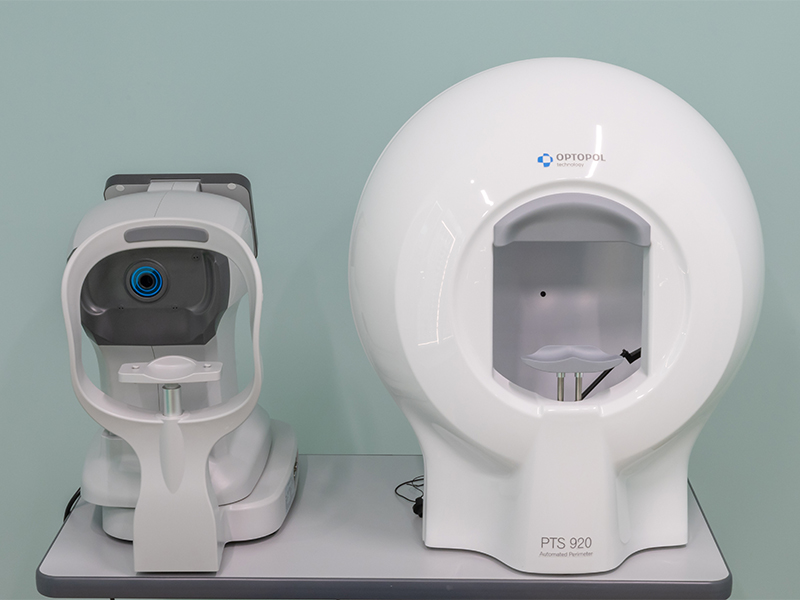About our eye test
Why choose us
Our state of the art equipment, the Vision R 800, revolutionises subjective refraction and prescription and together with our Visioffice X Optical Measuring System, provides a bespoke prescription with a resolution of up to 25 times enhanced. Witness the world with astonishing detail.

When should i get my eyes checked?
Even if you have no symptoms of a condition, you should have your eyes checked every two years. The eye exam is a routine health check that can uncover both underlying health issues and changes in your eyesight. Depending on your age and medical history, it may need to be more regular.
What are the costs?
For qualified customers, the NHS allows you to have a FREE eye examination at Frames Opticians and assistance with the cost of your glasses. More information about whether you are eligible for this assistance may be found here. If you do not qualify for NHS assistance, the eye test is currently free for a limited time only. Eye exams usually cost £25.

Your eye test explained
An eye test involves a series of checks to evaluate your vision and overall eye health. It can detect conditions early on, helping to preserve your vision and even uncover potential general health problems like hypertension and diabetes. Regular eye examinations are an essential part of maintaining your overall well-being.
The Pre Tests
A gentle puff of air will be blown into the surface of your eye by a tonometer. This will measure the internal pressure and is used to assess your risk of developing glaucoma.
We may use a fundus camera to take a photograph of the back of your eyes. The image that is taken will be saved and used to monitor any changes in eye health in future eye tests.
We will use a machine to help access how short or long-sighted you are by measuring the ability of your eyes to focus. We will ask you to look into the machine through two lenses and focus your eyes on an image that appears closer then further away. This is the first step in helping to calculate your prescription.
The Main Tests
A powerful microscope called a Slit lamp is used to examine your lens, iris and cornea, these are all located on the front surface of your eyes. We will check for scratches or abnormalities and is important for anyone who wears contact lenses.
Early stages of glaucoma is a condition that could be associated with headaches and other health issues. We can check for by doing a visual field test, the test assesses your ability to detect flashes of light in your peripheral (outer) vision.
This test will help to determine how lon or short-sighted you are by looking at how your eyes focus. One of our optometrists will shine a light into your eye while you focus on an item in the distance. They will then try out different lenses in front of your eyes which will help to determine your prescription. Pupil dilating drops can occasionally be used by your optometrist to get a clearer picture of your eye.
A Snellen test is the test that you will most likely recognise as the letter chart test. You will be asked to read from the chart and your optometrist will record how well you can see the letters with and without different strength lenses in front of your eyes. This test also helps to determine if you need a prescription and how strong the prescription needs to be.
The optometrist will ask you to read from a Snellen chart (also known as the letter chart test). This measures your visual acuity (i.e. how well you can see with and without lenses in front of your eyes) to determine whether you have 20/20 vision or whether a prescription is needed to give you the best vision possible.
The retina at the back of the eye, your optic nerve and its blood vessels are examined by a specialist torch called an Ophthalmoscope. This test checks that they are all healthy.
We can check the structures of your eyes in greater detail with an Optical Coherence Tomography scan (OCT scan). It allows us to see and understand what is going on beneath the surface of the eye and can help to detect sight-threatening eye conditions such as glaucoma and diabetic retinopathy. Check with your local practice of they are offering OCT scanning.
Visual Stress & Dyslexia
Treat visual stress and minimise the symptoms of Meares-Irlen Syndrome and dyslexia with the use of coloured lenses and overlays. The benefits can include:
- Improved readability
- Enhanced contrast
- Reduced glare
- Increased reading speed
- Better comprehension
It’s important to note that coloured overlays may not be effective for everyone. Each person’s visual symptoms and needs are unique, and a professional evaluation is essential to determine the most suitable treatment options.

